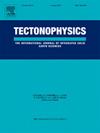Quaternary uplift on the southeastern coast of Cuba
IF 2.7
3区 地球科学
Q2 GEOCHEMISTRY & GEOPHYSICS
引用次数: 0
Abstract
The southeastern coast of Cuba is bounded on the south by the Oriente Fault Zone that corresponds to the northern Caribbean plate boundary. By analyzing the coastal terraces of this region, we decipher the Quaternary uplift along the transform plate boundary over a ∼ 380 km long coastal stretch. We present a detailed mapping of uplifted coastal terraces and 18 new U/Th ages of corals. Late Quaternary uplift rates range from −0.02 ± 0.02 to 0.23 ± 0.07 mm.yr−1. From west to east, the coastal sequences exhibit a maximum of 18 terraces culminating at 270 m on Cabo Cruz, 11 terraces reaching 250 m near Santiago de Cuba and 29 terraces up to 520 m on Punta Maísi. Coastal sequences reveal distinct tectonic regimes. In the west at Cabo Cruz, uplift results from the tilting of tectonic blocks separated by NE-SW-trending normal faults, to the north of an extensional step-over of the Oriente Fault Zone. In the central part, the uplift is associated with NW-SE folding linked to a transpressional relay zone of the Oriente Fault Zone and to the offshore E-W Santiago Deformation Belt. In the east, at Punta Maísi, uplift results from a north-dipping thrust close to the coast linked with the oblique collision of the Bahamas platform against Cuba. The intensity of coastal uplift and locations of relay zones seems related to lateral variations in rheology and thickness of the tectonic plates. The uplift of the coast of SE Cuba is controlled by the oblique collision of the Bahamas platform of the North America continental plate against the continental crust of the Caribbean plate to the east and the oceanic/continental transition of the Caribbean plate to the West.
古巴东南海岸第四纪隆起
古巴东南海岸的南部是东方断裂带,与加勒比海北部板块边界相对应。通过对该地区海岸阶地的分析,我们破译了第四纪沿转换板块边界的抬升,这条海岸延伸了约380公里。我们提出了一个详细的地图上升的海岸梯田和18个新的U/Th年龄的珊瑚。晚第四纪隆升速率为−0.02±0.02 ~ 0.23±0.07 mm.yr−1。从西到东,海岸序列显示出最多18个阶地,在Cabo Cruz达到270米,在古巴圣地亚哥附近达到11个250米,在Punta达到29个520米Maísi。海岸层序显示出独特的构造制度。在Cabo Cruz的西部,抬升是由东向西向的正断层分隔的构造块体的倾斜造成的,位于东方断裂带的伸展台阶的北部。在中部,隆升与北西-东南向褶皱有关,与东方断裂带的逆压接力带和海上东西向圣地亚哥变形带有关。在东部的Punta Maísi,隆起是由靠近海岸的北倾推力引起的,这与巴哈马地台与古巴的斜向碰撞有关。海岸隆升的强度和中继带的位置似乎与构造板块的流变学和厚度的横向变化有关。古巴东南海岸的隆升受北美大陆板块的巴哈马地台与东部加勒比海板块的大陆地壳的斜向碰撞和西部加勒比海板块的洋陆过渡控制。
本文章由计算机程序翻译,如有差异,请以英文原文为准。
求助全文
约1分钟内获得全文
求助全文
来源期刊

Tectonophysics
地学-地球化学与地球物理
CiteScore
4.90
自引率
6.90%
发文量
300
审稿时长
6 months
期刊介绍:
The prime focus of Tectonophysics will be high-impact original research and reviews in the fields of kinematics, structure, composition, and dynamics of the solid arth at all scales. Tectonophysics particularly encourages submission of papers based on the integration of a multitude of geophysical, geological, geochemical, geodynamic, and geotectonic methods
 求助内容:
求助内容: 应助结果提醒方式:
应助结果提醒方式:


